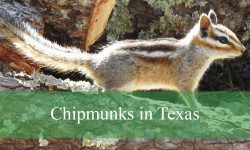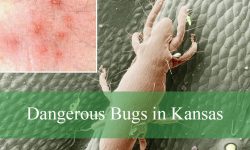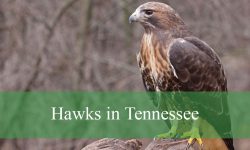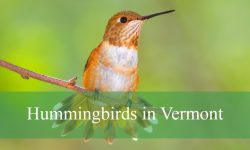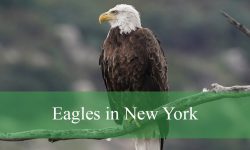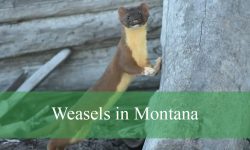Georgia is a fantastic destination for birdwatchers, especially during migration seasons when a dazzling variety of warblers pass through the state. From vibrant yellow and orange hues to striking black-and-white patterns, the diversity of Warblers in Georgia offers endless fascination for both beginners and seasoned birders alike.
Warblers in Georgia inhabit a wide range of habitats, including pine forests, wetlands, and leafy woodlands. In parks, forests, and even backyard gardens, these small, energetic songbirds can often be seen flitting among the trees and shrubs.
This guide introduces 26 Warblers in Georgia with detailed pictures and identification tips. Learn how to recognize each species by their unique colors, songs, and behaviors, and discover when and where you’re most likely to see them throughout the year.
Common Warblers Found in Georgia
Pine Warbler
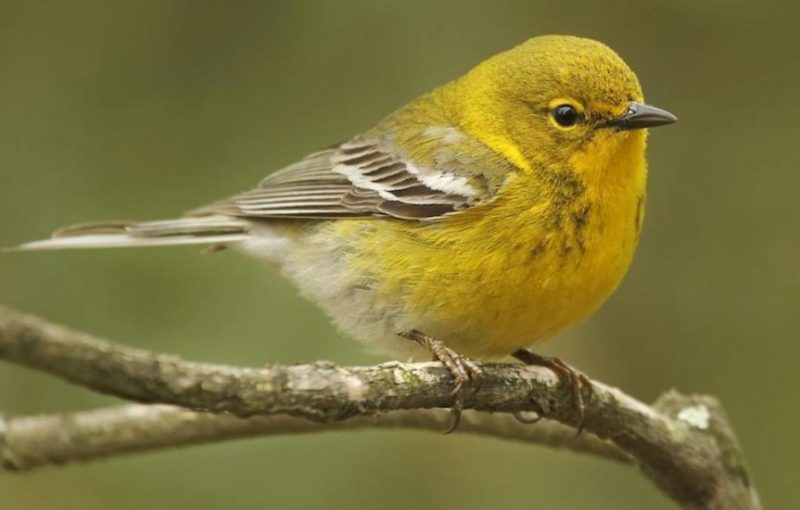
The Pine Warbler is one of the few warbler species found year-round in Georgia, especially in pine-dominated woodlands. Males are olive-yellow on the throat and breast, with a grayish back and white wing bars, while females and juveniles are paler and less vivid. Their sturdy body and slightly longer bill compared to other warblers help in identifying them in the field.
This species often forages high in pine trees, where it feeds on insects, spiders, and seeds—especially pine seeds in winter. Unlike many warblers, Pine Warblers are known to visit feeders, particularly those offering suet or sunflower seeds during colder months. Their foraging behavior includes hopping along branches and picking food from needles and bark.
The song of the Pine Warbler is a musical, rolling trill, softer than a Chipping Sparrow’s but similar in rhythm. It’s one of the earliest warblers to sing in spring, sometimes starting as early as February in southern Georgia. They nest in pine trees, often placing their cup-shaped nests high on branches, well hidden among needles.
Yellow-throated Warbler
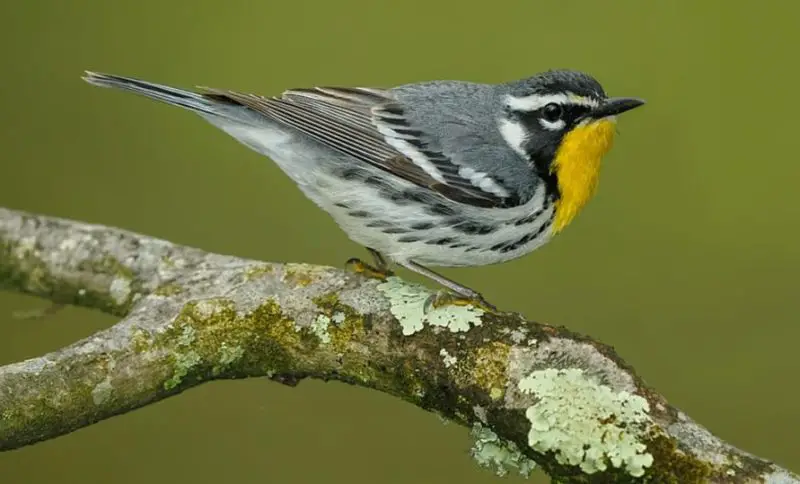
The Yellow-throated Warbler is a vibrant and elegant species easily recognized by its bright yellow throat, bold black facial stripes, and crisp white belly. A white eyebrow and long, slightly downcurved bill complete its striking look. It is slightly larger than most warblers, measuring about 5.5 inches in length.
This species prefers tall, mature trees—especially sycamores, pines, and cypresses—where it gleans insects and spiders from leaves and bark. It’s an agile climber and often forages along tree trunks and limbs, in a manner reminiscent of nuthatches. In Georgia, it breeds mainly in the Coastal Plain and Piedmont but can be found statewide during migration.
Its song is a series of clear whistles that rise slightly in pitch, often described as “see-you, see-you, sweet-sweet-sweet.” The Yellow-throated Warbler nests high in trees, weaving its nest in hanging Spanish moss or in pine needles. It’s most commonly observed in bottomland forests, cypress swamps, and pine woods, particularly in southern Georgia.
Prothonotary Warbler
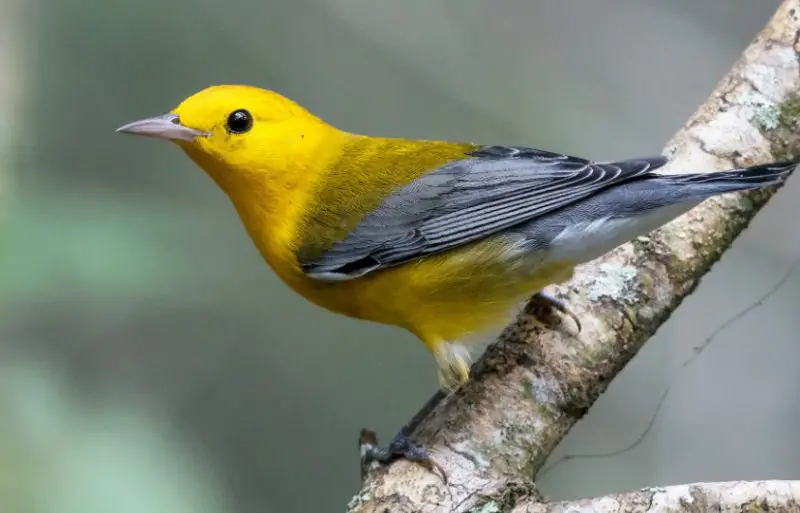
The Prothonotary Warbler is a glowing presence in Georgia’s wooded wetlands, with its rich yellow head and underparts contrasting with blue-gray wings and a short tail. This species lacks wing bars and features large, dark eyes that give it a gentle expression. It’s often called the “swamp warbler” due to its habitat preferences.
Unlike most warblers, Prothonotary Warblers nest in tree cavities, typically near or over water. They are highly dependent on bottomland forests, cypress swamps, and floodplain habitats. During the breeding season, they are usually found in southern Georgia, especially along slow-moving rivers and wetlands with dense vegetation.
Their song is a loud, sweet series of repeated notes, often rendered as “sweet-sweet-sweet-sweet.” Males sing persistently during spring and early summer to defend territory. For food, they hunt insects and larvae by hopping through low vegetation or picking prey off bark and leaves. These warblers migrate to Central and northern South America for winter.
Common Yellowthroat
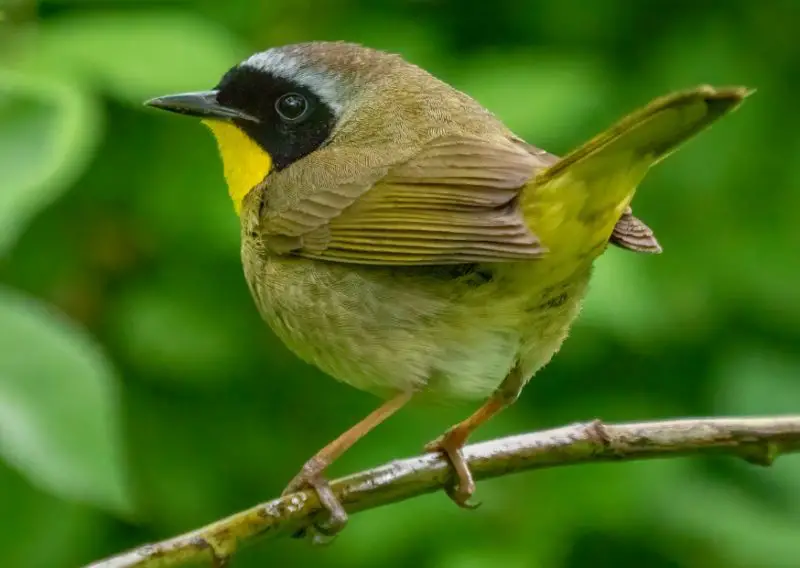
The Common Yellowthroat is one of the most widespread warblers in Georgia, easily recognized by the adult male’s distinctive black face mask bordered with white and its bright yellow throat and chest. Females lack the mask and are plainer olive with a yellowish wash, making identification slightly trickier.
This species prefers wet, tangled habitats such as marshes, weedy fields, and shrubby edges near water. It’s most often seen flitting low through reeds, cattails, and dense brush. Common Yellowthroats breed across much of Georgia and remain in the southern part of the state throughout winter, making them familiar to many birders.
Their song is a sharp, rhythmic “wichity-wichity-wichity,” repeated frequently and often heard before the bird is seen. They are insectivorous and forage near the ground, actively searching for spiders, beetles, and other small invertebrates. This warbler’s adaptability and bold behavior make it one of the most frequently encountered warblers in the state.
Ovenbird
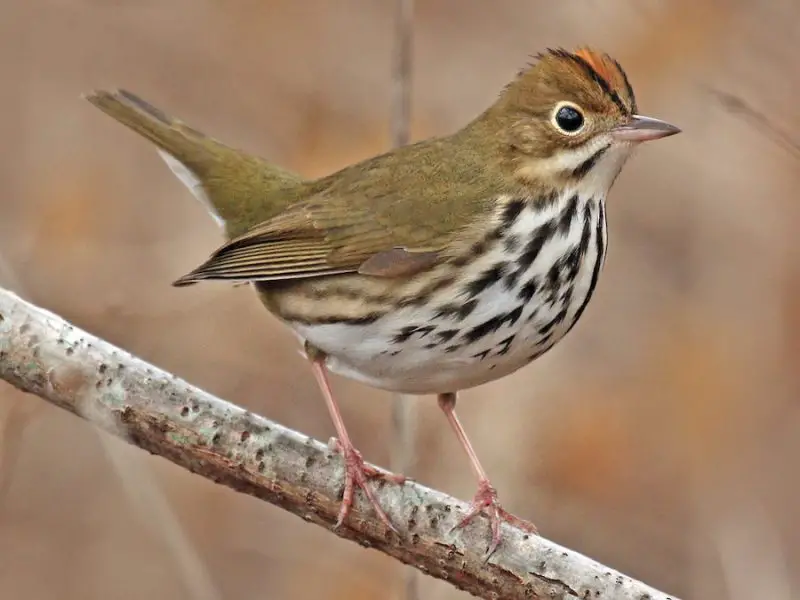
The Ovenbird is a ground-dwelling warbler with olive-brown upperparts, a white belly marked with dark streaks, and a distinctive bold white eye stripe. Its appearance is more thrush-like than most warblers due to its upright stance and pink legs. It gets its name from its unique nest, which resembles a Dutch oven and is built on the forest floor.
Ovenbirds are most commonly found in mature deciduous and mixed forests, especially those with dense understory and leaf litter. They forage on the ground, flipping leaves in search of insects, spiders, and other invertebrates. In Georgia, they are primarily seen during spring and fall migration but also breed in northern parts of the state at higher elevations.
Their song is a loud and emphatic “teacher-teacher-teacher,” repeated in a rising tempo that carries through the forest. They are easier to hear than to see, as they tend to stay hidden among the underbrush. The Ovenbird’s strong voice and secretive nature make it a distinctive yet elusive presence in Georgia’s wooded habitats.
Louisiana Waterthrush
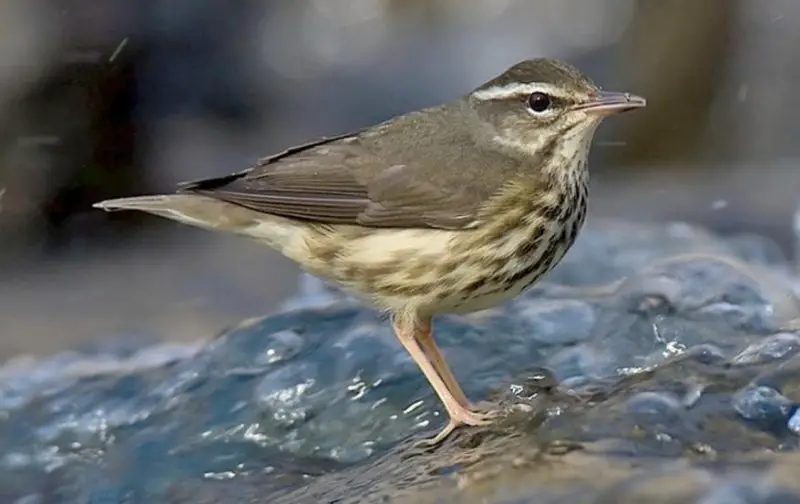
The Louisiana Waterthrush is a unique warbler that resembles a thrush, with brown upperparts, a white belly, and a bold white eyebrow stripe. It has a relatively large body for a warbler and long legs that help it navigate rocky streambanks. Its constant tail-bobbing behavior is a key field mark when spotted near water.
This species favors clean, fast-moving streams in mature forest settings, especially in hilly or mountainous regions of Georgia. It walks rather than hops along stream edges, where it hunts aquatic insects, snails, and larvae. The Louisiana Waterthrush is one of the earliest migrant warblers to return to Georgia in spring, sometimes arriving in March.
Its song is loud and ringing, with a series of clear notes followed by a tumbling warble. Males sing frequently from low perches along streams to defend territory. They nest in hidden spots near the ground, often in roots or mossy streambanks, making their breeding sites vulnerable to water pollution or habitat disturbance.
Northern Parula
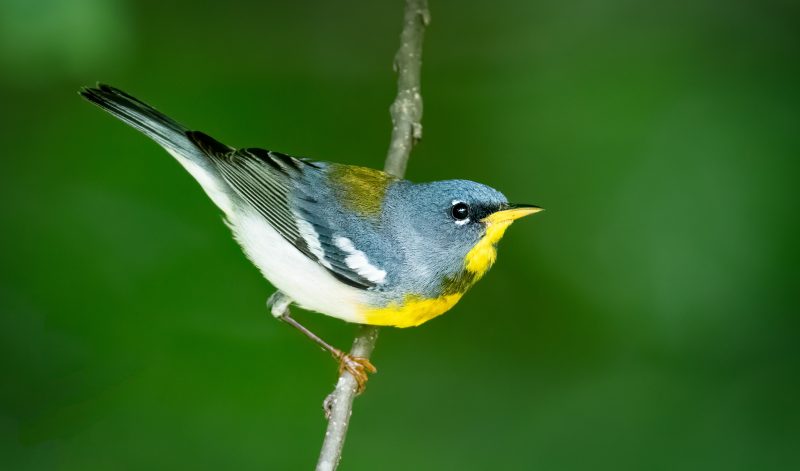
The Northern Parula is a small, colorful warbler with a bluish-gray back, yellow throat and chest, and a greenish patch on the back. Males have a distinctive bluish band across the chest, while both sexes show white crescents above and below the eye. Its compact body and short tail give it a rounded appearance.
In Georgia, Northern Parulas are commonly found in mossy forests, especially those draped in Spanish moss or old man’s beard lichen, which they use to build their hanging nests. These warblers forage high in the canopy, gleaning caterpillars, spiders, and other small insects from leaves and branches. They are a regular breeder across the state, especially in the Coastal Plain and Piedmont.
Their song is a rising buzzy trill, often described as “zee-up!” or “zeeeeeeeee-yip,” and is commonly heard from early spring through summer. Despite their bright colors, they can be hard to spot due to their preference for the upper canopy. Their presence is most often revealed by their unique song echoing through southern woodlands.
Yellow Warbler
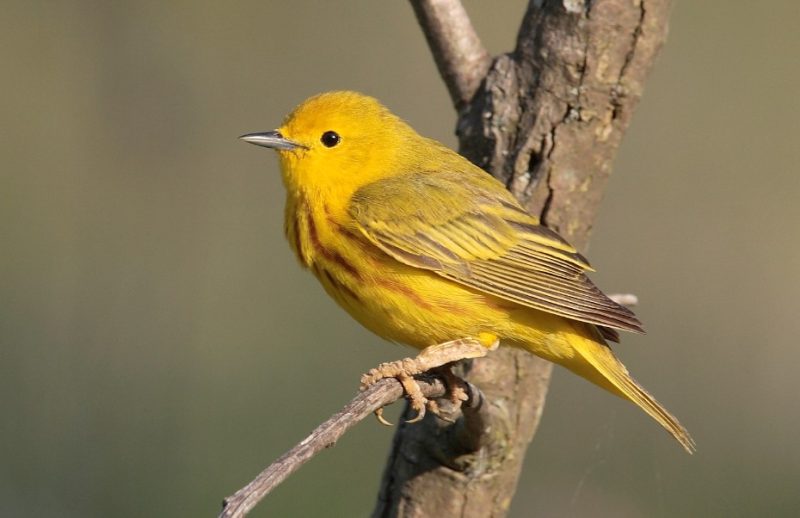
The Yellow Warbler is one of the brightest and most cheerful warblers in Georgia, with golden-yellow plumage and fine reddish streaks on the chest in males. Females and juveniles are more uniformly yellow without the bold streaks. Their short, slightly curved bill and rounded shape are helpful for quick identification.
These warblers prefer shrubby wetlands, overgrown fields, and forest edges, where they build their nests in dense vegetation. In Georgia, they are most commonly seen during migration, but some populations breed in the northern parts of the state. They feed on a variety of insects and caterpillars, including leafhoppers and beetles, which they pick from leaves and twigs.
Their song is a rapid, sweet “sweet-sweet-sweet, I’m so sweet,” repeated often and delivered from an open perch. Yellow Warblers are active and vocal, often flitting through willows, alders, or roadside thickets. Their vivid coloration and persistent song make them a welcome sight in spring and early summer landscapes.
Black-and-white Warbler
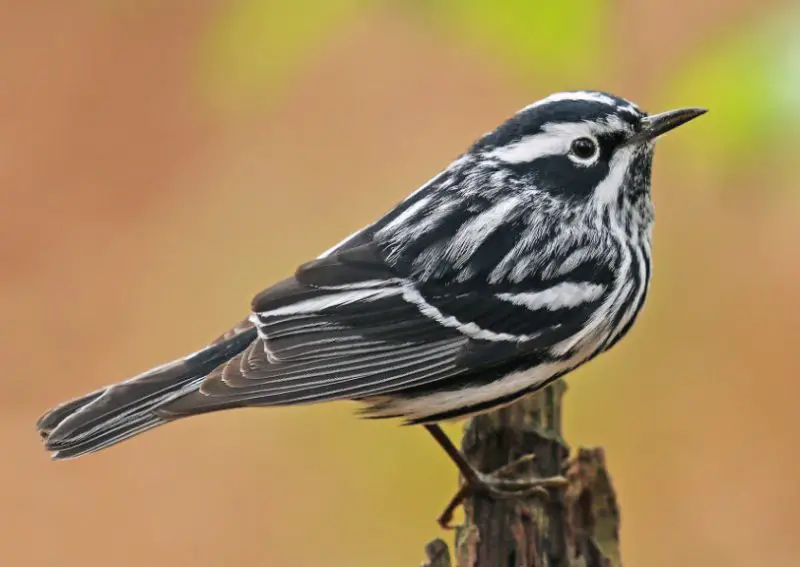
The Black-and-white Warbler is instantly recognizable by its striking zebra-like plumage—black-and-white stripes run vertically on the body, with a white belly and black streaks throughout. Males are more boldly patterned, while females have grayer tones and less contrasting markings. This warbler has a slightly downcurved bill and a nuthatch-like posture.
Unlike most warblers, this species forages by creeping along tree trunks and large branches, using its strong legs and sharp bill to probe into bark crevices for insects and spiders. It behaves much like a nuthatch, moving both upward and downward along tree bark. Black-and-white Warblers breed in northern Georgia and pass through the entire state during migration.
Its song is a high, squeaky “wee-see, wee-see, wee-see,” often described as sounding like a squeaky wheel. The call is thin but persistent, helping birders locate this secretive species in wooded habitats. They nest on the ground at the base of trees or in leafy forest undergrowth, usually near mixed deciduous woods.
American Redstart
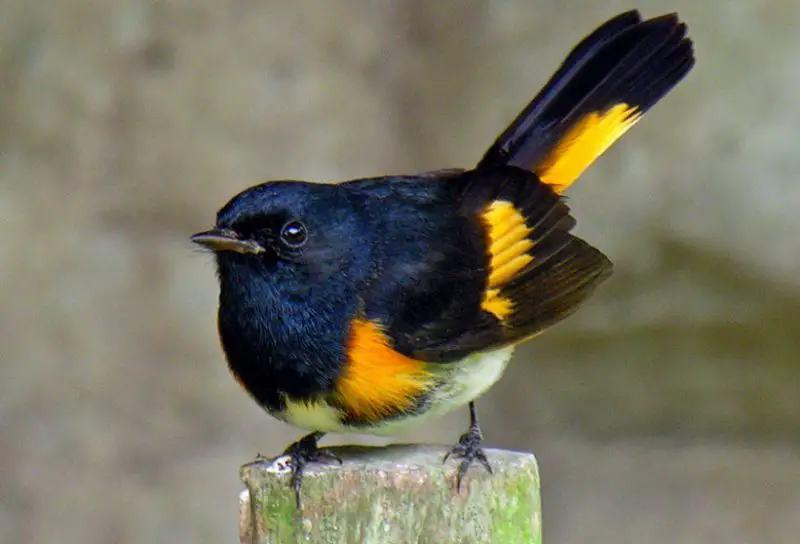
The American Redstart is a flashy and energetic warbler known for its bold colors and constant movement. Adult males are mostly black with bright orange patches on the sides, wings, and tail, while females and immature birds are grayish with yellow highlights instead of orange. Their fanned tail is frequently flicked open to reveal bright flashes of color.
This species is highly active, flitting through trees and shrubs in search of insects, often using its tail and wings to flush prey from foliage. In Georgia, American Redstarts breed in moist forests and wooded stream corridors in the northern parts of the state, and they are widespread migrants throughout the rest of Georgia.
Their song is a variable series of high, sharp notes that often end in an upward flourish, such as “see-see-see-ooh.” Males sing frequently during the breeding season from mid to high perches. Redstarts are easy to spot during migration due to their energetic foraging style and distinctive color pattern, even when seen briefly.
Cape May Warbler
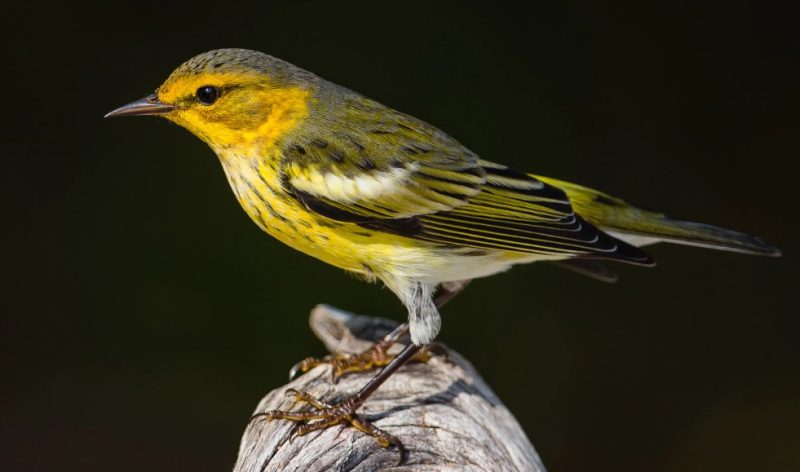
The Cape May Warbler is a beautifully patterned warbler, especially in spring when males show a chestnut cheek patch, bold yellow throat, and tiger-striped breast. Females and non-breeding males are paler with less distinct facial markings but still have a noticeable yellow wash and streaked underparts. This species has a slender, slightly curved bill.
Cape May Warblers are primarily migrants in Georgia, most commonly seen in late April through May and again in fall. They prefer coniferous forests for breeding far to the north, but during migration, they stop in a variety of wooded habitats, especially where flowering trees or insect-rich foliage is abundant.
Their song is a high-pitched, buzzy trill that can be hard to hear or locate. They feed on insects and will also sip nectar or fruit juices during migration, sometimes even visiting hummingbird feeders. Their brief presence in Georgia during migration makes them a prize find for keen-eyed birders.
Black-throated Blue Warbler
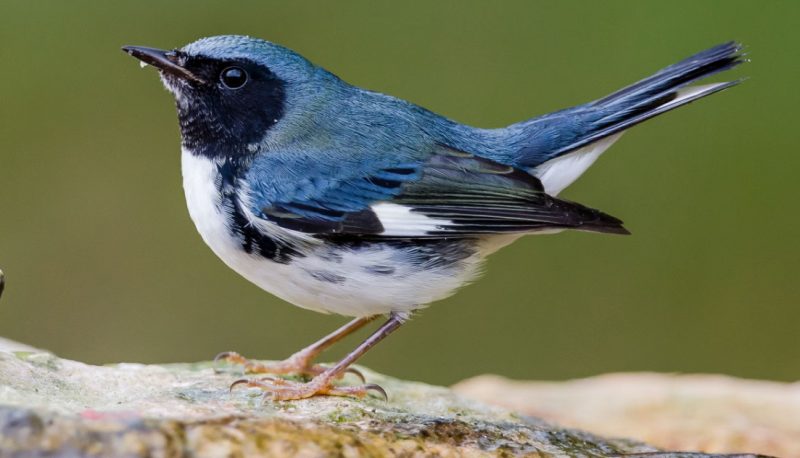
The Black-throated Blue Warbler is a striking forest warbler, with males showing deep midnight-blue backs, black faces and throats, and clean white underparts. A small white patch at the base of the wing is a reliable field mark. Females are a dull olive-brown with pale yellowish undersides and a faint white arc below the eye.
In Georgia, this species breeds in the cooler, higher elevations of the northern mountains, particularly in mature deciduous forests with dense understory. They forage slowly and deliberately, picking insects from leaves rather than flitting rapidly like many other warblers. During migration, they may appear in forests and wooded parks across the state.
Their song is a buzzy, rising phrase—often rendered as “zoo-zoo-zoo-zree!”—that’s easy to recognize once learned. Their call note is a soft “tsip.” Black-throated Blue Warblers build cup-shaped nests close to the ground in shrubs or saplings, often hidden among rhododendron or mountain laurel in their breeding range.
Black-throated Green Warbler
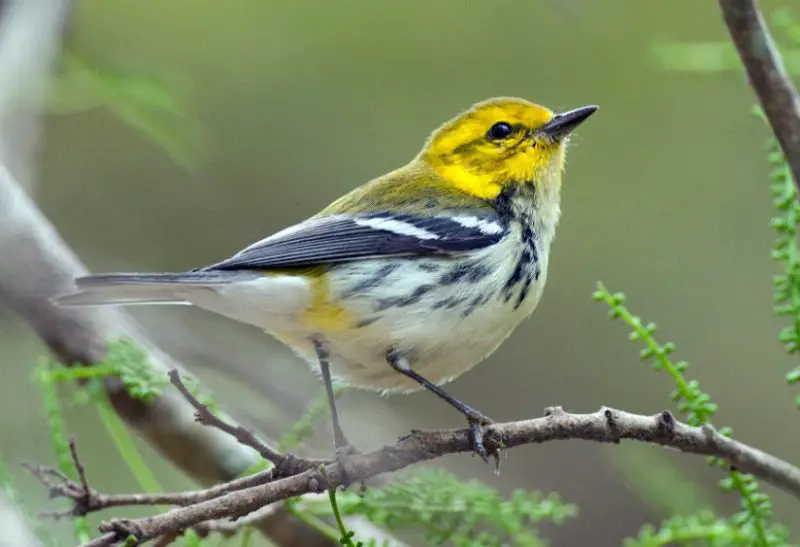
The Black-throated Green Warbler is a bright and distinctive species with a vivid yellow face, greenish back, and black throat patch in males. The underparts are white with black streaking on the flanks. Females and immatures are paler and may lack the solid black throat, but the yellow face remains a key feature.
This species breeds in coniferous and mixed forests at higher elevations in northern Georgia, where it can be heard singing persistently throughout spring and summer. It forages actively in the canopy, hunting for caterpillars and other small insects. During migration, it may pass through other parts of the state, particularly in wooded habitats.
Its song is a buzzy, easily remembered “zee-zee-zee-zoo-zee,” repeated frequently from high branches. Males use their song to establish and defend territories. Though small, the Black-throated Green Warbler is highly vocal and visually striking, making it a favorite among birdwatchers in the Appalachian foothills and mountain forests.
Magnolia Warbler
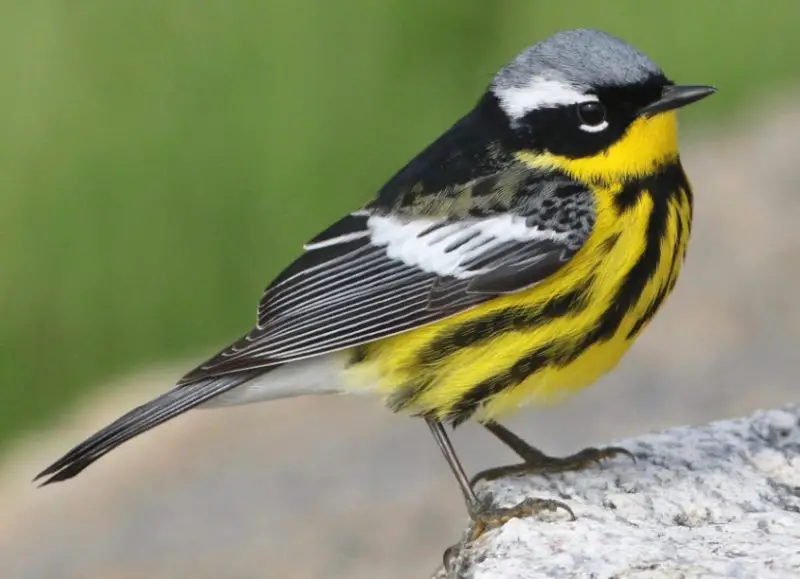
The Magnolia Warbler is a striking species with bold coloration, especially in breeding males that show vivid yellow underparts with thick black streaks, a black necklace across the chest, and a gray back with a white eyebrow. Females and nonbreeding birds are more subdued but still display the characteristic yellow belly and some streaking.
In Georgia, Magnolia Warblers are most often seen during spring and fall migration as they pass through forested areas. They tend to favor dense shrubs and low branches, where they forage for insects and caterpillars. Though they breed in northern boreal forests, their migration route reliably brings them through much of Georgia.
Their song is a musical phrase that rises and falls quickly, often described as “weeta-weeta-weetsee.” Magnolia Warblers are active and responsive to pishing, which can make them easier to spot during migration. Their bright plumage and unique patterning make them a favorite target for birdwatchers in the Southeast during migration seasons.
Bay-breasted Warbler
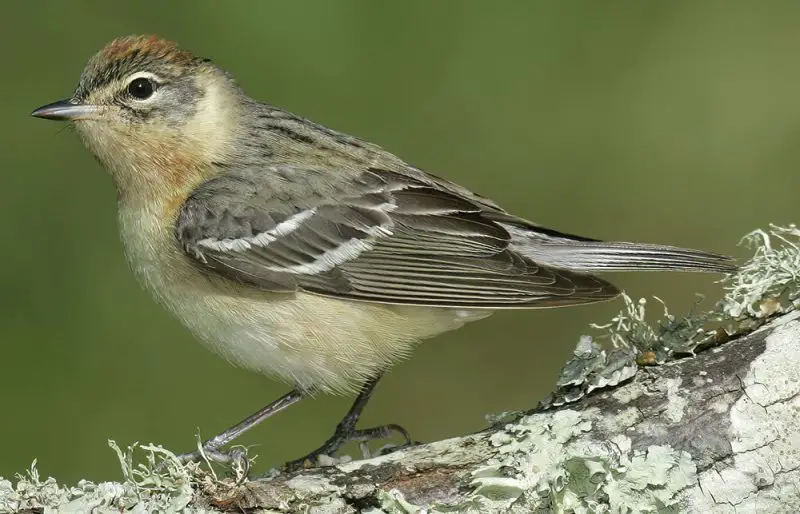
The Bay-breasted Warbler is a large, chunky warbler with a short tail and thick neck. In breeding plumage, males are a rich mix of chestnut on the throat, flanks, and crown, with black face markings and a creamy nape. Females and nonbreeding birds are much duller, showing more greenish tones and only a hint of chestnut.
This species passes through Georgia mainly during migration in spring and fall, with peak numbers typically in May and September. It prefers mature deciduous forests and is often seen higher in the canopy, gleaning insects from foliage. During fall, they may be mistaken for Blackpoll Warblers due to similar appearance when not in breeding plumage.
Their song is a series of thin, high-pitched notes, often hard to distinguish from other high-singing warblers. Bay-breasted Warblers breed in the boreal forests of Canada and winter in Central and South America. Their chestnut tones in spring make them one of the most visually distinctive warblers seen during migration in Georgia.
Chestnut-sided Warbler

The Chestnut-sided Warbler is easily identified by its vivid breeding plumage—bright yellow crown, black eye-line, white underparts, and rich chestnut flanks. Females and fall birds are more olive-green above and lack the strong chestnut coloring but often retain the yellow cap and white underparts.
This species is most frequently observed in Georgia during migration, although it occasionally breeds in the far northern counties. It prefers shrubby habitats, forest edges, and regenerating woodlands, where it forages in lower to mid-level vegetation for insects and larvae. Its bold plumage and active behavior make it noticeable during spring.
The Chestnut-sided Warbler’s song is a cheerful and memorable phrase, often transcribed as “pleased, pleased, pleased to meetcha!” They are especially vocal in spring, and their combination of bright coloring and distinctive song makes them a delight to encounter during migration.
Palm Warbler
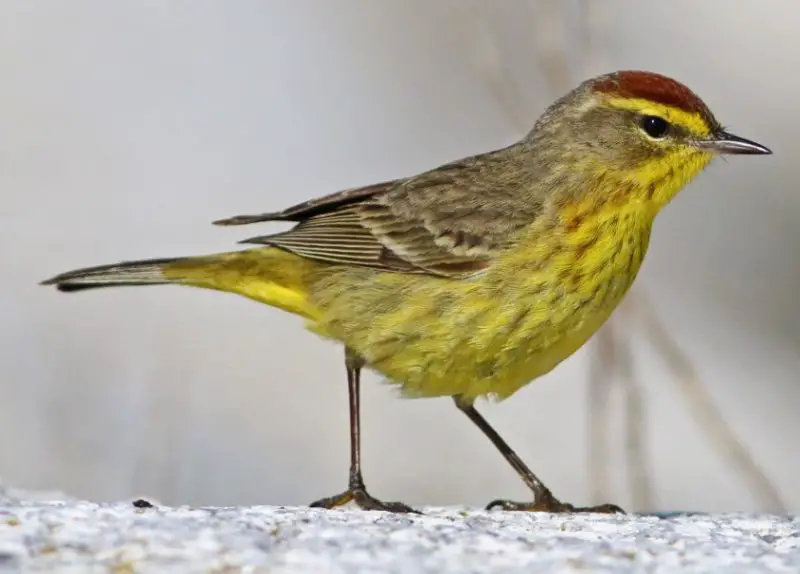
The Palm Warbler is a familiar migrant and winter resident in Georgia, especially in open areas such as grassy fields, weedy lots, and the edges of woodlands. It is best recognized by its constant tail-bobbing behavior and warm brown upperparts with yellow under the tail and throat. Breeding birds show more yellow throughout and have a rusty cap.
Unlike many warblers, Palm Warblers are often seen on the ground or low shrubs, where they forage for insects and small invertebrates. In Georgia, they are commonly found from fall through early spring, especially in the Coastal Plain and along the coast. Their tame nature and tail-wagging make them easy to identify even at a distance.
Their song is a short, buzzy trill, not often heard in wintering grounds, but their call—a sharp “tsip”—is frequently given as they move through grass or low brush. Because they winter in much of the southeastern U.S., including Georgia, Palm Warblers are often one of the most frequently observed warblers outside the breeding season.
Tennessee Warbler
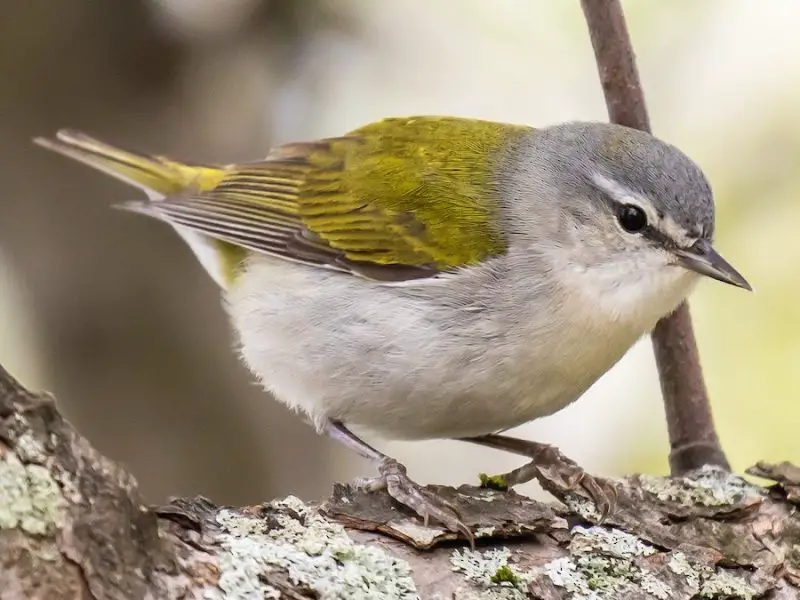
The Tennessee Warbler is a small, slender songbird with a plain olive-green back and pale underparts. It lacks strong facial markings, though a faint eyebrow and thin bill help with identification. Despite the name, it does not breed in Tennessee but was first recorded there during migration.
This species passes through Georgia during spring and fall migration and is often found in mixed flocks, foraging in trees for caterpillars and other small insects. It prefers forest edges, shrubby areas, and open woods. Its high energy and quick movements can make it difficult to spot, but it’s often located by its song.
The Tennessee Warbler has a loud, rapid trill composed of several sharp notes, delivered in a rising series. Males are especially vocal on the breeding grounds but may sing during migration as well. Though not brightly colored, its energetic behavior and distinct vocalizations make it a notable migrant in Georgia.
Prairie Warbler
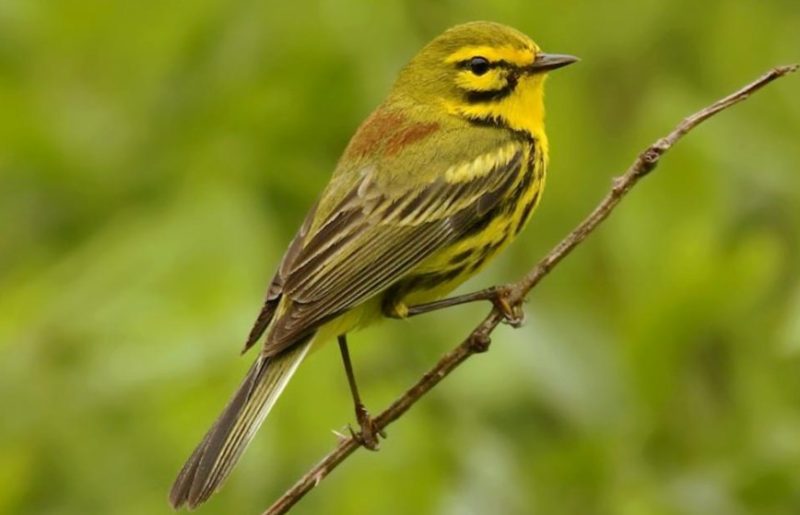
The Prairie Warbler is a slender, active songbird with bright yellow underparts and bold black streaks along its sides. Males also show a black semicircle beneath the eye and an olive-green back with chestnut patches. Females and immatures are paler but still maintain the general yellow-and-green color scheme.
This species favors scrubby habitats, overgrown fields, regenerating forests, and pine barrens—especially in the Coastal Plain and Piedmont regions of Georgia. It forages actively in low shrubs and small trees, hunting for small insects and spiders. Prairie Warblers are summer residents in much of the state and are often among the first warblers to return in spring.
Their song is a rising, buzzy “zee-zee-zee-zee,” increasing in pitch and intensity, and often repeated persistently. Males sing from exposed perches and are very territorial during breeding season. Despite their name, they are rarely found in true prairies and instead thrive in early-successional or fire-maintained habitats.
Wilson’s Warbler
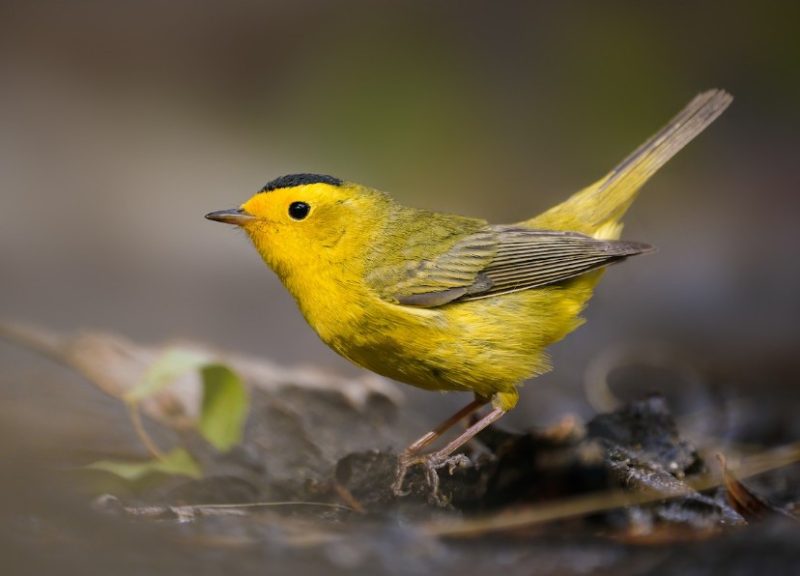
Wilson’s Warbler is a small, bright yellow warbler with a plain face and a distinct black cap on adult males. Females and immature birds lack the cap or show only a faint gray crown. Their compact size, rounded head, and constantly flicking tail help distinguish them from other yellow warblers.
This species is primarily a migrant in Georgia, typically seen in April to May and again in late August through September. It prefers dense shrubs, forest edges, and streamside thickets during migration, often foraging low to the ground for insects. Wilson’s Warblers are quick-moving and can be tricky to spot unless they pause briefly.
Their song is a chattering series of sharp, sweet notes, sometimes compared to a rushed version of a wren’s song. Though rarely heard in Georgia, their “chik” call note is frequently given while foraging. Birders are often excited to encounter this species, especially in shaded or wet woodland habitats during migration.
Hooded Warbler
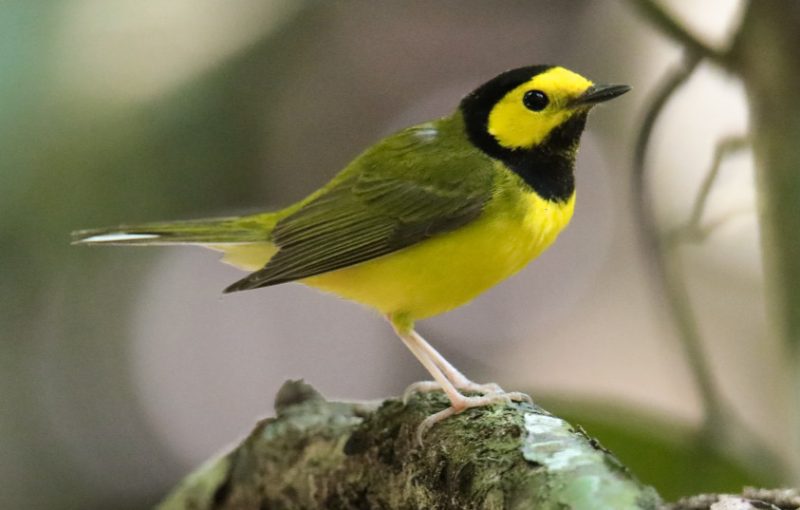
The Hooded Warbler is a stunning forest species with a rich yellow face and underparts, and in males, a bold black hood that covers the head and throat. Females lack the full black hood but may show a dusky cap or throat patch. Both sexes have large white tail spots that flash in flight or when the tail flicks open.
This warbler breeds throughout the southeastern U.S., including much of Georgia, especially in moist deciduous forests with dense understory. It forages near the ground and mid-level vegetation, often flicking its tail and wings to startle insects. Hooded Warblers are strongly territorial and tend to return to the same breeding sites year after year.
Their song is a loud, ringing “weeta-weeta-weet-tee-o!” that carries well through the forest. Males sing persistently in spring and summer. Their preference for thick woodland understory makes them easier to hear than to see, though patient birders can often glimpse one foraging in the shadows.
Cerulean Warbler
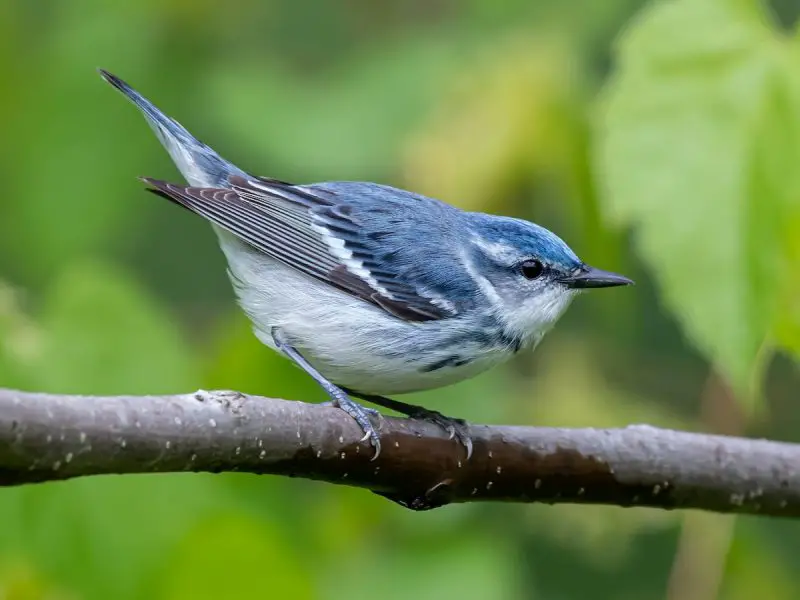
The Cerulean Warbler is a small, canopy-dwelling warbler with striking plumage. Males are sky-blue above with a white underside and a narrow black necklace across the upper chest. Females are bluish-green above with a pale yellow wash below and lack the chest band. Their small size and short tail add to their delicate appearance.
This species is considered rare in Georgia and is most often found in the northern part of the state during migration or occasionally breeding in mature deciduous forests at higher elevations. Cerulean Warblers prefer large tracts of unbroken forest, where they forage high in the canopy, gleaning caterpillars and other insects from leaves.
Their song is a fast, buzzy series of rising notes, often rendered as “zray-zray-zray-zray-zree.” Because of their scarcity and canopy-loving habits, Cerulean Warblers are highly sought after by birders. Continued habitat loss has led to significant population declines, making Georgia sightings increasingly special.
Worm-eating Warbler
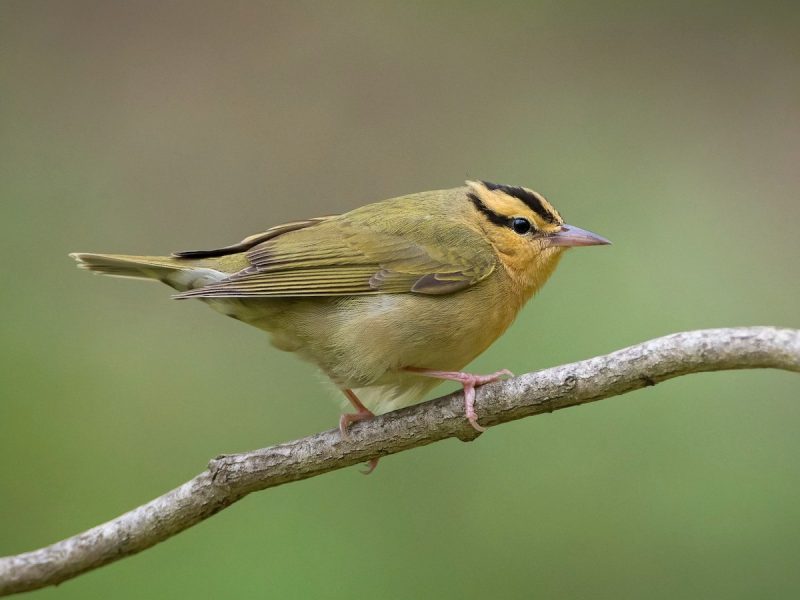
The Worm-eating Warbler is a subtly colored warbler with olive-brown plumage and distinctive black crown stripes on a buffy head. It has a slender, pointed bill and a plain body with no streaking below. Despite its name, it does not specialize in eating worms, but instead feeds mostly on insects and caterpillars.
This species breeds in wooded hillsides, ravines, and mature forests with thick leaf litter, especially in the Piedmont and mountainous regions of Georgia. It forages quietly in the understory and along the forest floor, often hidden among dense vegetation. Its nest is built on the ground, well camouflaged by leaves and debris.
The Worm-eating Warbler’s song is a dry, insect-like trill that resembles the sound of a Chipping Sparrow but is slower and more deliberate. Males sing persistently from hidden perches, and the species can be challenging to observe due to its secretive nature and preference for dense, shaded environments.
Kentucky Warbler
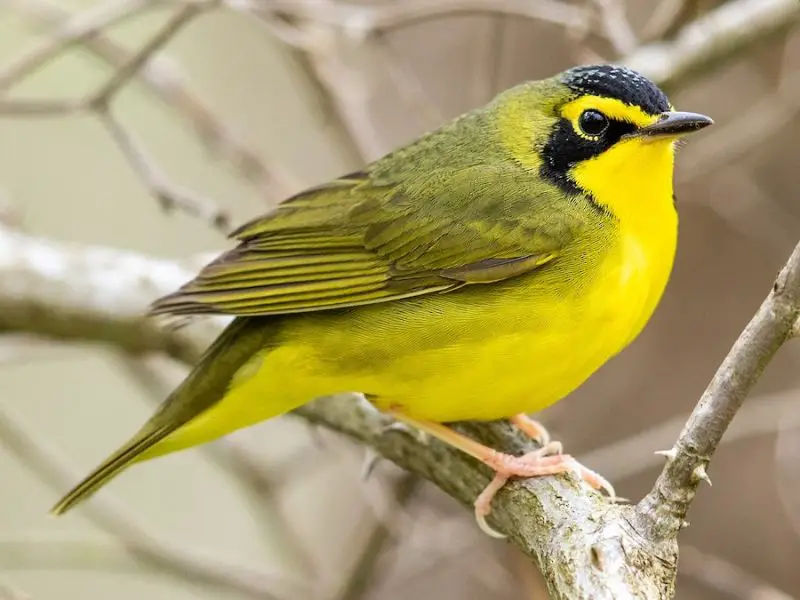
The Kentucky Warbler is a brightly colored, ground-foraging species with a vivid yellow face and underparts, accented by a bold black mask and sideburns in males. The back is olive green, and the body is plump and short-tailed, giving it a thrush-like appearance. Females have a fainter mask but retain the yellow facial pattern.
In Georgia, Kentucky Warblers breed in moist deciduous forests with dense understory, especially in the Piedmont and northern portions of the state. They are often found near streams and thickets where they forage close to the ground, flipping leaves in search of insects, beetles, and larvae. Their secretive behavior makes them difficult to spot, though their loud voice gives them away.
Their song is a rich, rolling series of notes often written as “turdy-turdy-turdy,” loud and emphatic. The call is a sharp “chip” given frequently when alarmed. This warbler’s preference for dense foliage and lower forest levels makes it a challenge to see but a treat to hear during spring and summer.
Canada Warbler
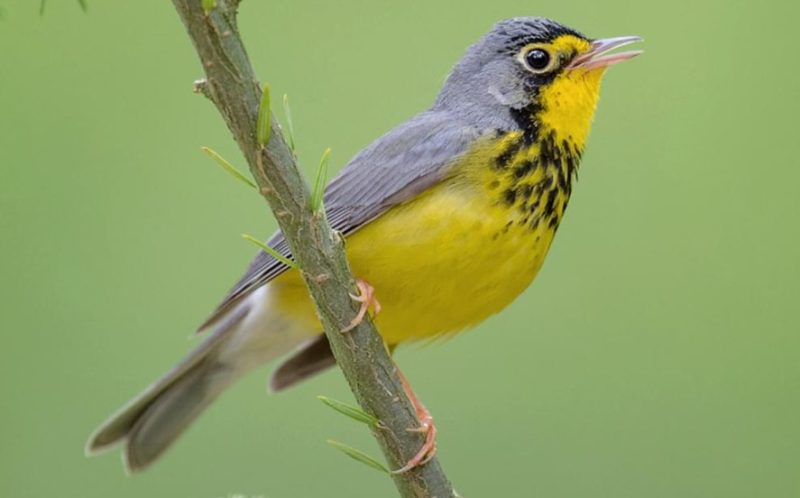
The Canada Warbler is a beautiful and distinctive warbler with a slate-gray back, bright yellow underparts, and a necklace of dark streaks across the chest. Males have bolder markings, while females are slightly paler with a less defined necklace. Both sexes show bold white eye-rings, giving them a wide-eyed look.
In Georgia, Canada Warblers are seen primarily during spring and fall migration as they pass through wooded areas, often in moist forests or riparian corridors. They are active foragers, moving quickly through shrubs and lower branches in search of insects. Although they breed farther north, their presence in Georgia during migration is welcomed by birders.
Their song is a musical and varied warble, often including short, sweet phrases that differ between individuals. Though their singing is brief during migration, their “chink” call note is commonly heard as they forage. Their striking plumage and energetic behavior make them a highlight among spring migrants in Georgia.
FAQ About Warblers in Georgia
What are the most common warblers in Georgia?
Common warblers in Georgia include the Pine Warbler, Yellow-throated Warbler, Common Yellowthroat, Black-and-white Warbler, and American Redstart. Many species migrate through Georgia during spring and fall.
When is the best time to see warblers in Georgia?
The best times are during spring migration (April to May) and fall migration (September to October). Some warblers also breed in Georgia and can be seen in summer.
Where do warblers typically live in Georgia?
Warblers inhabit a variety of habitats including pine forests, deciduous woodlands, wetlands, shrubby fields, and riparian areas. Specific species prefer different habitats based on their feeding and nesting needs.
What do warblers eat?
Warblers primarily eat insects and spiders. During migration and winter, some species also consume berries and small fruits.
How can I attract warblers to my backyard in Georgia?
Plant native trees and shrubs that provide insects, berries, and shelter. Installing bird feeders with mealworms and providing fresh water can also help attract warblers.
Do warblers stay in Georgia year-round?
Most warblers are migratory, spending only part of the year in Georgia. However, species like the Pine Warbler and Yellow-throated Warbler are often year-round residents.
What are some key identification tips for warblers?
Look for distinctive color patterns, wing bars, throat markings, and behavior such as foraging style and song. Many warblers have unique songs that can help with identification.
Are warblers endangered or threatened in Georgia?
Some warbler species face habitat loss and population declines, but most common warblers in Georgia are not currently endangered. Conservation efforts help protect their habitats.
Can warblers be seen in urban areas of Georgia?
While most warblers prefer natural habitats, some species may visit urban parks, gardens, and green spaces during migration.
What is the difference between resident and migratory warblers in Georgia?
Resident warblers live and breed in Georgia year-round, while migratory warblers pass through during seasonal migrations to breed elsewhere or winter in warmer regions.

